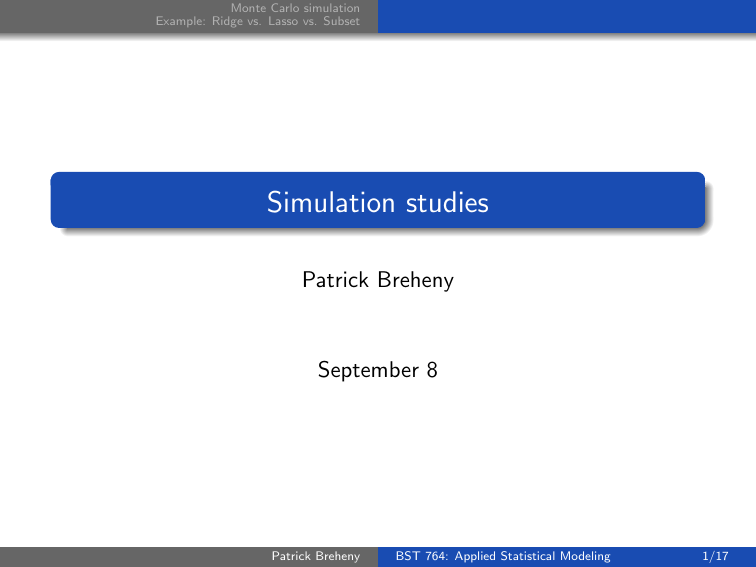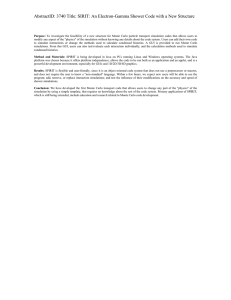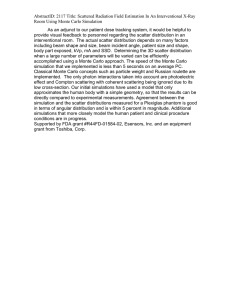Simulation studies
advertisement

Monte Carlo simulation
Example: Ridge vs. Lasso vs. Subset
Simulation studies
Patrick Breheny
September 8
Patrick Breheny
BST 764: Applied Statistical Modeling
1/17
Monte Carlo simulation
Example: Ridge vs. Lasso vs. Subset
Introduction
In statistics, we are often interested in properties of various
estimation and model selection procedures: bias, variance,
mean squared error, how often a certain variable is selected,
etc.
Suppose we have data x1 , . . . , xp , y with distribution f (x, y);
denote our estimate g(x, y) and our quantity of interest (e.g.,
the variance of the estimator) as h(g)
In principle, we could calculate the expected value of our
quantity of interest by evaluating the integral
Z Z
Z
· · · h(g(x, y))f (x, y)dx1 · · · dxp dy
Patrick Breheny
BST 764: Applied Statistical Modeling
2/17
Monte Carlo simulation
Example: Ridge vs. Lasso vs. Subset
Monte Carlo simulation
Clearly, this integral is well beyond our means to evaluate
except in special cases
We can, however, approximate the integral via simulation
To do this, we generate x and y from f (x, y), then calculate
g(x, y) and h(g)
We do this repeatedly, and obtain the random variables
{h1 , h2 , . . . , hN }
Patrick Breheny
BST 764: Applied Statistical Modeling
3/17
Monte Carlo simulation
Example: Ridge vs. Lasso vs. Subset
Monte Carlo simulation
Now, by the law of large numbers,
lim
N →∞
h1 + · · · + hN
= E[h(g(x, y))],
N
our quantity of interest
Although we cannot actually carry out this simulation an
infinite number of times, we can obtain accurate
approximations of our quantity of interest by running a large
number of simulations (N )
This technique of approximation is known as Monte Carlo
simulation or Monte Carlo integration
Patrick Breheny
BST 764: Applied Statistical Modeling
4/17
Monte Carlo simulation
Example: Ridge vs. Lasso vs. Subset
General framework
The general framework for writing code to accomplish this is
for (i in 1:N)
{
Data = GenerateData()
Estimate[i] = g(Data$X,Data$y)
}
h(Estimate)
In general, and especially if the simulation is time-consuming, it is
best to record and save all the estimates so that later on, you can
calculate all the quantities of interest that occur to you
Patrick Breheny
BST 764: Applied Statistical Modeling
5/17
Monte Carlo simulation
Example: Ridge vs. Lasso vs. Subset
Extending the general framework
The general framework on the previous slide can be extended in
many ways; suppose we wish to generate data according to several
distributions and compare several different estimators:
for (i in 1:N)
{
for (j in 1:J)
{
Data = GenerateData(j)
for (k in 1:K)
{
Estimate[i,j,k] = g(Data$X,Data$y,k)
}
}
}
apply(Estimate,2:3,h)
Patrick Breheny
BST 764: Applied Statistical Modeling
6/17
Monte Carlo simulation
Example: Ridge vs. Lasso vs. Subset
Principles of experimental design
Note that a simulation is an experiment, and the general
principles of experimental design are often relevant
For example, in the previous slide, I blocked on Data in order
to eliminate variability due to data generation from my
comparison of the estimators
Patrick Breheny
BST 764: Applied Statistical Modeling
7/17
Monte Carlo simulation
Example: Ridge vs. Lasso vs. Subset
Simulations in SAS?
I will be focusing here on carrying out simulations in R
SAS can also be used to carry out simulations, although the
language is not designed for this purpose, and therefore
requires the use of tools such as macros to set up variables and
arrays that can be used across DATA and PROC statements
This is not a severe impediment for simple simulations
involving a small number of variables, but it becomes a
burden when dealing with multivariable models
Nevertheless, if you wish to see how one might set up a
multivariable simulation of ridge regression vs. OLS in SAS,
check the SAS code for this lecture
Patrick Breheny
BST 764: Applied Statistical Modeling
8/17
Monte Carlo simulation
Example: Ridge vs. Lasso vs. Subset
Overview
To illustrate the principles of simulation design, we will
implement a simulation study comparing ridge regression,
lasso, and subset selection
To better illustrate the structure of the simulation, and so
that the code fits on a single slide, we will break down this job
into several tasks:
Generating the data
Carrying out ridge regression
Carrying out the lasso
Carrying out subset selection
Comparing the three methods
Patrick Breheny
BST 764: Applied Statistical Modeling
9/17
Monte Carlo simulation
Example: Ridge vs. Lasso vs. Subset
Generating the data
genData <- function(n,p,beta)
{
X <- matrix(runif(n*p),nrow=n,ncol=p)
y <- rnorm(n,X%*%beta)
return(list(X=X,y=y))
}
Possible changes/extensions: allowing the user to change σ 2 ,
different distribution for y, different distribution for X, correlation
among the columns of X
Patrick Breheny
BST 764: Applied Statistical Modeling
10/17
Monte Carlo simulation
Example: Ridge vs. Lasso vs. Subset
Ridge regression
ridge <- function(Data,n.lam=301)
{
require(MASS)
lam <- c(0,exp(seq(log(1e-2),log(1e7),len=n.lam)))
fit <- lm.ridge(y~X,Data,lambda=lam)
return(coef(fit)[which.min(fit$GCV),])
}
Feel free to check that this range of λ values is reasonable by
inserting a plot statement
Patrick Breheny
BST 764: Applied Statistical Modeling
11/17
Monte Carlo simulation
Example: Ridge vs. Lasso vs. Subset
Best subsets
bestsub <- function(Data)
{
require(leaps)
fit <- regsubsets(y~X,Data)
b <- numeric(ncol(Data$X)+1)
names(b) <- fit$xnames
bb <- coef(fit,which.min(summary(fit)[["bic"]]))
b[names(bb)] <- bb
return(b)
}
Possible changes/extensions: allowing the user to specify selection
via Cp instead of BIC
Patrick Breheny
BST 764: Applied Statistical Modeling
12/17
Monte Carlo simulation
Example: Ridge vs. Lasso vs. Subset
Lasso
lasso <- function(Data)
{
require(glmnet)
cvfit <- cv.glmnet(Data$X,Data$y)
return(as.numeric(coef(cvfit,s=cvfit$lambda.min)))
}
Note that as.numeric is required here because glmnet stores its
values in a special “sparse matrix” format
Patrick Breheny
BST 764: Applied Statistical Modeling
13/17
Monte Carlo simulation
Example: Ridge vs. Lasso vs. Subset
Putting it all together
N <- 100
beta <- c(2,-2,rep(0,8))
p <- length(beta)
results <- array(NA,dim=c(N,p,4),
dimnames=list(1:N,1:p,c("Subset","Lasso","Ridge","OLS")))
for (i in 1:N)
{
Data <- genData(100,p,beta)
results[i,,1] <- bestsub(Data)[-1]
results[i,,2] <- lasso(Data)[-1]
results[i,,3] <- ridge(Data)[-1]
results[i,,4] <- coef(lm(y~X,Data))[-1]
displayProgressBar(i,N)
}
Patrick Breheny
BST 764: Applied Statistical Modeling
14/17
Monte Carlo simulation
Example: Ridge vs. Lasso vs. Subset
Looking at quantities of interest
B <- apply(results,2:3,mean)-beta
V <- apply(results,2:3,var)
MSE <- B^2+V
apply(MSE,2,sum)
Obviously, there are many other ways to carry out this simulation,
each with its own strengths and weaknesses, so feel free to modify
everything
Patrick Breheny
BST 764: Applied Statistical Modeling
15/17
Monte Carlo simulation
Example: Ridge vs. Lasso vs. Subset
Looking at quantities of interest (cont’d)
One advantage to saving all the estimates, however, is that it
allows you to look at other quantities of interest after the
simulation is over, such as:
ylim <- range(results)
boxplot(results[,,1],col="gray",ylim=ylim,main="Subset")
boxplot(results[,,2],col="gray",ylim=ylim,main="Lasso")
Lasso
●
●
●
●
●
●
●
●
●
●
●
●
●
●
●
●
●
●
●
●
●
●
●
●
●
●
●
●
●
●
●
●
●
●
●
●
●
●
●
●
●
●
●
●
●
●
●
●
●
●
●
●
●
●
●
●
●
●
●
●
●
●
●
●
●
●
●
●
●
●
●
●
●
●
●
●
●
●
●
●
●
●
●
●
●
●
●
●
●
●
●
●
●
●
●
●
●
●
●
●
●
●
●
●
●
●
●
●
●
●
●
●
●
●
●
●
●
●
●
●
●
●
●
●
●
●
●
●
●
●
●
●
2
3
4
5
6
7
8
9
10
●
●
−1
●
●
●
●
●
●
7
8
9
10
−2
●
−2
●
−1
0
●
●
0
●
●
●
1
1
2
3
●
●
●
●
2
3
Subset
1
2
3
4
5
6
Patrick Breheny
1
BST 764: Applied Statistical Modeling
16/17
Monte Carlo simulation
Example: Ridge vs. Lasso vs. Subset
How many simulations?
As we said earlier, if N is large, our answer should be very
close to the actual mean squared error (or whatever our
quantity of interest may be)
In the preceding code, I used N = 100; is that large enough?
To answer this question, we can use standard confidence
interval techniques to assess the variability of the mean
So, for example, the standard error of β̂1Subset was 0.41; thus,
with N = 100, our results are accurate to within about ±0.08;
with a sample size of N = 1000, we could cut that to ±0.03
Of course, it would also take 10 times as long to run; in
reality, there is a tradeoff between accuracy and
computational burden that depends on the problem
Patrick Breheny
BST 764: Applied Statistical Modeling
17/17





